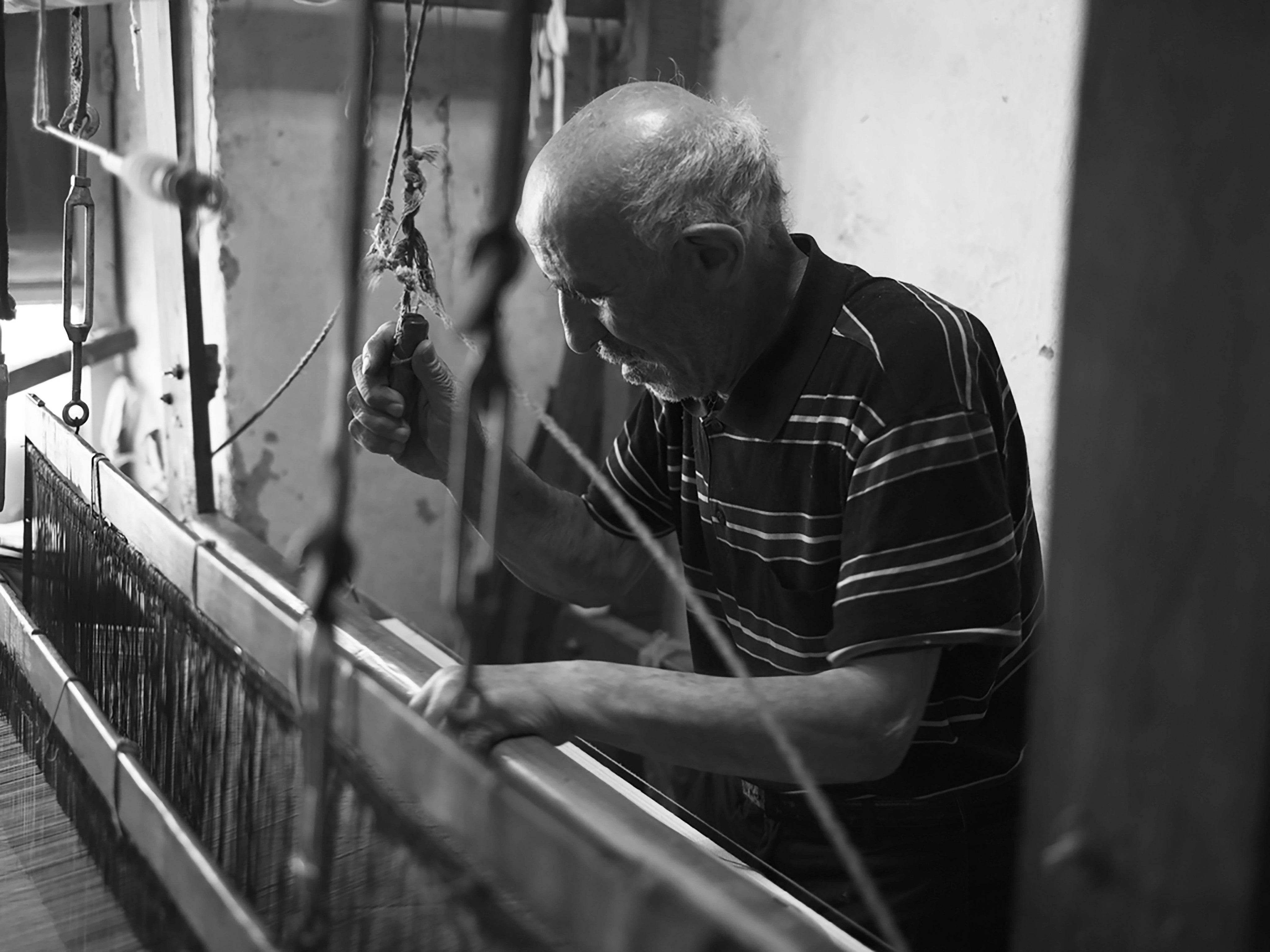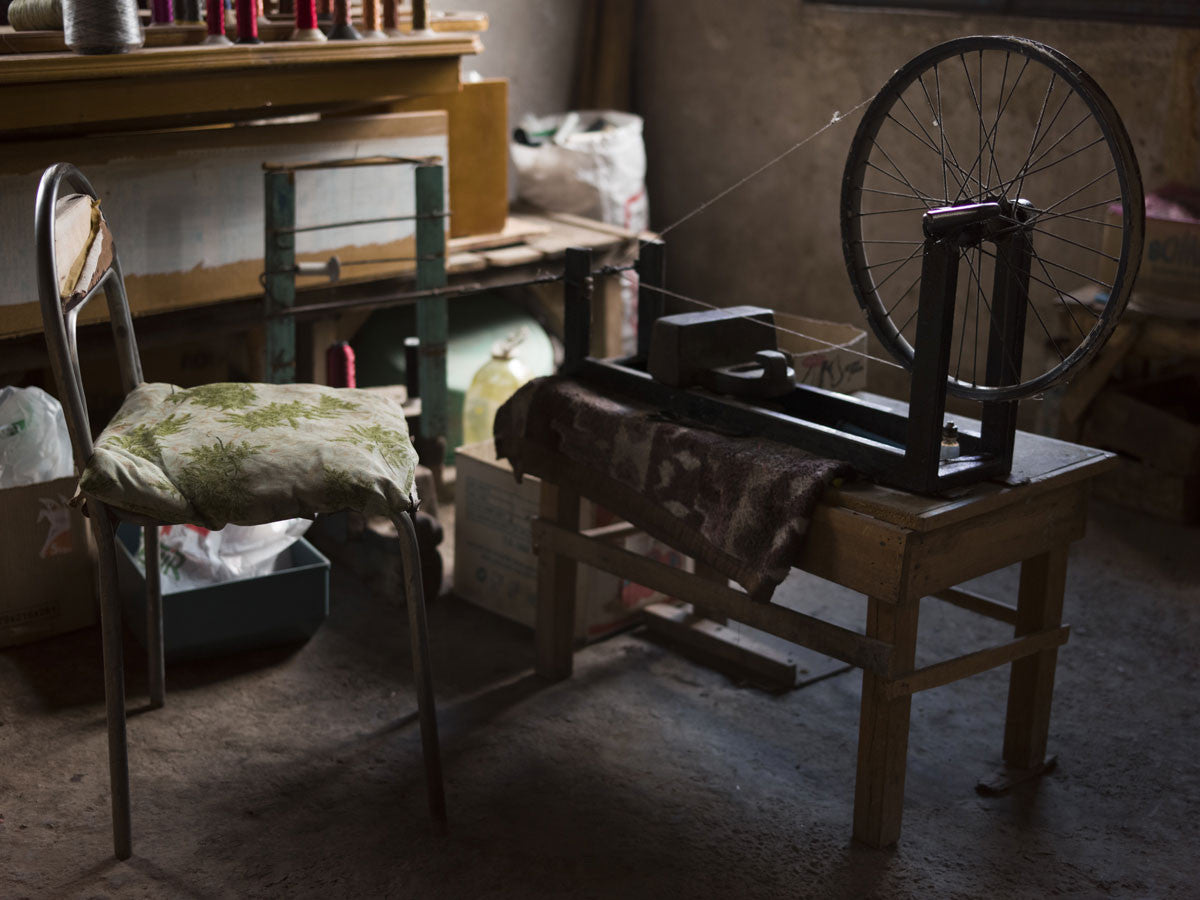THE MASTER OF CRAFT
A WEAVER'S VILLAGE
BULDAN, TURKEY
Scroll to explore
The Story
A CONVERSATION WITH THE WEAVERS OF BULDAN BULDAN, TURKEY
The sound of the loom is the signature song of the town of Buldan, a well-known weaver's enclave in the inner Aegean region of Denizli, Turkey where the tradition is believed to date to Roman times as far back as 800 BC. For much of the past, cotton sourced from nearby fields traveled into the village where nearly every home had a hand loom and at least one family member contributing to the making of local peshtemal garments and towels. Today, much of the work is done by modern machines in large, regional factories, while only a small group of weavers, from ages twenty to ninety-three, continue to make the homespun creations by hand or by mechanized work benches.

There was a
MUSTAFA GULBAY, MAYOR OF BULDAN
rhythm to the whole neighborhood,
like a heart beat.
S+O — DESCRIBE THE CULTURAL SIGNIFICANCE OF TEXTILE WEAVING IN BULDAN.
Mustafa Gülbay [Mayor] — Buldan, and the surrounding area, has a very rich tradition of weaving. In the ruins of a villa in Tripolis, archeologists discovered ancient mosaics believed to be two or three thousand years old depicting a weaving design of a four-headed snake which symbolizes health and a potent production of goods. Many generations of weavers came from this village. I remember, as a child, the noises of the weaving workshops, including my mother’s work, that used to disperse from every home. It sounded like music. There was a rhythm to the whole neighborhood, like a heart beat.
Turgut Efeoğlu [Weaver] — Our fathers, who started this tradition thousands of years ago, immigrated from different parts of Anatolia living and operating as raiders. We followed their footsteps and their traditions, and started making all these goods here.
Raziye Kirsoy [Weaver] — History says our textiles were in demand by the Ottoman sultans. Sultan Beyazit's daughter's wedding dress was weaved here centuries ago.

S+O — WHY DO YOU BELIEVE THE CULTURE DEVELOPED HERE?
M. Gülbay — In this area, including Tripolis, there are many hot springs containing water that has healing effects. A spa culture developed, which was very popular with the Romans at the time, and along with it, weaving. The advantage was that the spring waters were already hot so they didn’t need to be heated to prepare the materials for weaving. There is plenty of archeological evidence to support this.
S+O — HOW WAS THE TRADITION OF WEAVING PASSED DOWN TO YOU?
T. Efeoğlu — I inherited my home and this trade from my grandfather who was a weaver one hundred and twenty years ago. It’s been passed from father to son fostering generations of craftsmen throughout the years. Today, I work alongside my son.
R. Kirsoy — I was born into this. I have known the art of weaving as long as I have known myself. This knowledge was passed from my grandparents to my parents and then to me. Today, I am seventy-one. I have taught my children this skill as well.
Ahmet Basuymaz [Weaver] — I didn’t come from a family of weavers. I started as an apprentice since there weren’t any other job opportunities in the area besides textile production. I’m ninety-two years old now, and I still continue to enjoy this work.




S+O — HOW HAS THE CREATIVE PROCESS CHANGED OVER TIME?
A. Efeoğlu — For as long as one can remember, this work was done with bare hands and a hand loom. In the last fifty to sixty years, technology intervened in the process. It has started to become mechanized. This has made our work easier, but it has moved the work out of the home and into the factories in many cases.
A. Basuymaz — There used to be at least one loom in every single home. Sometimes there were two work benches. However, the production was very limited because everything was done by hand. The machinery has allowed the process to become faster and more efficient. I’m the only one left who weaves solely by hand. I believe the quality of hand weaving items is better since it is a more traditional and intimate form of art.
For as long as can be remembered, this work was done with bare hands and a hand loom.
AHMET EFEOGLU , BULDAN WEAVER

S+O — WHAT ARE THE MAIN PRODUCTION DIFFERENCES?
A. Efeoglu — We can produce seven to eight peshtemals a day using the hand weaving technique, but with the work bench, we can produce one item every fifteen to twenty minutes. It’s still a small amount. The work bench is not a large factory machine that can produce industrial quantities of goods. It is a simple machine using a simple process. We can create around four hundred peshtemals per month this way. But with hand weaving we can do around two hundred, only half the amount.


S+O — WHAT KIND OF MATERIALS ARE USED?
A. Efeoğlu — There are few types of peshtemals, including a garment worn here, and a popular towel style. For the garments, peshtemals can be made out of silk, bamboo, and cotton. For the towels, they are always made out of cotton.
S+O — WHY IS THIS TRADITION IMPORTANT TO PRESERVE?
R. Kirsoy — It is important, because this is how we have always made a living in this community. We have been carrying on the tradition of quality craftsmanship and beautiful weaving work for many generations. We don’t want this to disappear. We want it to survive and to be passed on to the next generation. But for it to be preserved, the world has to recognize its importance.
For it to be
RAZIYE KIRSOY, BULDAN WEAVER
preserved, the world
must recognize its
importance.

Credits
Photography by Clement Jolin
Film by Oresti Tsonopoulos and Alexandra Stewart
Special Acknowledgments - Mehmet Ali Babaoğlu
Yasemin Pirinçcioğlu, Özgür Ayaşlıoğlu and Kursat Taner Unal of VIP Tourism
The Objects
Exclusive Edition 012 Buldan Peshtemal Towels
The peshtemal towel is synonymous with Turkish bathing culture. The thinly woven sheet is widely used in hamams and bath houses around the world, but has become increasingly popular around the world for its durability and ability to absorb water quickly.
The Destination
BULDAN, TURKEY
The Denizli province, including the village of Buldan, is deeply rooted in Turkey's rich textile cultural legacy with quality cotton grown in the area for the expert weavers to craft their wares, including peshtemal towels which originate from the region. The abundant mineral springs throughout the area allowed it to develop as a prominent spa destination from Roman times until today. The relics and ruins of these settlements set within the otherworldly landscapes, such as the UNESCO World Heritage site Pamukkale, are associated with these healing waters, and can still be enjoyed by travelers in the here and now.



